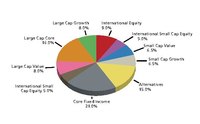
Photo from wikipedia
Abstract In defined contribution (DC) pension schemes, the regulator usually imposes asset allocation constraints (minimum and maximum limits by asset class) in order to create funds with different risk–return profiles.… Click to show full abstract
Abstract In defined contribution (DC) pension schemes, the regulator usually imposes asset allocation constraints (minimum and maximum limits by asset class) in order to create funds with different risk–return profiles. In this article, we challenge this approach and show that such funds can exhibit erratic risk–return profiles that deviate significantly from the intended design. We propose to replace all minimum and maximum asset allocation constraints by a single risk metric (or measure) that controls risk directly. Thus, funds with different risk–return profiles can be immediately created by adjusting the risk tolerance parameter accordingly. Using data from the Chilean DC pension system, we show that our approach generates funds whose risk–return profiles are consistently ordered according to the intended design, and outperforms funds created by means of asset allocation limits.
Journal Title: Insurance: Mathematics and Economics
Year Published: 2019
Link to full text (if available)
Share on Social Media: Sign Up to like & get
recommendations!